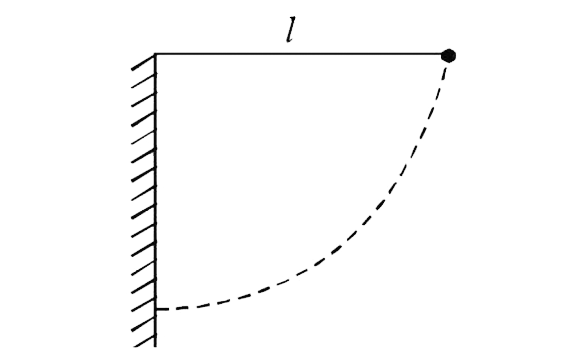A simple pendulum is suspended from a peg on a vertical wall. The pendulum is pulled away from the wall to a horizontal postion (see fig .) and released. The ball hits the wall, the coefficient fo restituation being 2√5 What is the minimum number of collisions after which the amplitude of oscillations becomes less than 60 degress ?

6
3
5
4
The correct Answer is:B
Step by step video solution for A simple pendulum is suspended from a peg on a vertical wall. The pendulum is pulled away from the wall to a horizontal postion (see fig .) and released. The ball hits the wall, the coefficient fo restituation being (2)/(sqrt5) What is the minimum number of collisions after which the amplitude of oscillations becomes less than 60 degress ? by Physics experts to help you in doubts & scoring excellent marks in Class 11 exams.
Updated on:21/07/2023Similar Questions
A simple pendalum is suspended from a peg on a verticle wall . The pendulum is pulled away from the well is a horizental position (see fig) and released . The bell his the well the coefficient of resitution being 2√5

what is the miximum number of colision after which the amplitube of secillections between less that 60 digree ?
View SolutionA simple pendalum is suspended from a peg on a verticle wall . The pendulum is pulled away from the well is a horizental position (see fig) and released . The bell his the well the coefficient of resitution being 2√5

what is the miximum number of colision after which the amplitube of secillections between less that 60 digree ?
View SolutionA small ball is projected from point P towards a vertical wall as shown in Fig. It hits the wall when its velocity is horizontal. Ball reaches point P after one bounce on the floor. The coefficient of restitution assuming it to be same for two collisions is n/2. All surfaces are smooth. Find the value of n.

View SolutionA girl throws a ball with an initial velocity v at an angle 45∘. The ball strikes a smooth vertical wall at a horizontal distance d from the girl and after rebound returns to her hands. What is the coefficient of restitution between wall and ball ? (v2>dg)
View SolutionA girl throws a ball with initial velocity v at an inclination of 45∘. The ball strikes a smooth vertical wall at a horizontal distance d from the girl and after rebounding returns to her hand. What is the coefficient restitution between the all and the ball ?
View SolutionA boy throws a ball with initial speed √ag at an angle θ to the horizontal. It strikes a smooth vertical wall and returns to his hand. Show that if the boy is standing at a distance 'a' from the wall, the coefficient of restitution between the ball and the wall equals 1(4sin2θ−1). Also show that θ cannot be less than 15∘.
View SolutionA small ball is suspended from point O by a thread of length l. A nail is driven into the wall at a distance of l/2 below O, at A. The ball is drawn aside so that the thread takes up a horizontal position at the level of point O and then released. Find
a. At what angle from the vertical of the ball's trajectory, will the tension in the thread disappear?
b. What will be the highest point from the lowermost point of circular track, to which it will rise?
View SolutionFor the arrangement shown in figure, the spring is initially compressed by 3cm. When the spring is released the block collides with the wall and rebounds to compress the spring again.

(a) If the coefficient of restitution is 1√2 , find the maximum compression in the spring after collision.
(b) If the time starts at the instant when spring is released, find the minimum time after which the block becomes stationary.
View SolutionA ball is projected from a given point with velocity u at some angle with the horizontal and after hitting a vertical wall returns to the same point. Show that the distance of the point from the wall must be less than eu2(1+e)g, where e is the coefficient of restitution.
View SolutionA steel ball is suspended by a light in extensible string of length l from a fixed point O. When the ball is in equilibrium it just touches a vertical wall as shown in the figure. The ball is first taken aside such that string becomes horizontal and then released from rest. If coefficient of restitution is e, then find the maximum deflection of the string after nth collision.

View Solution
